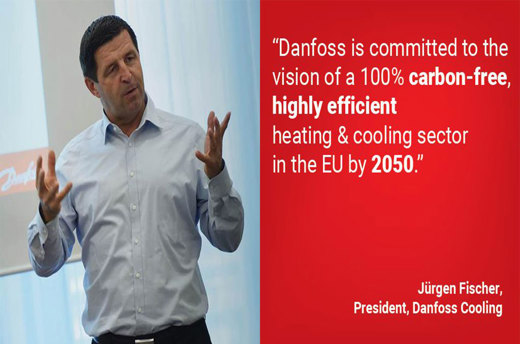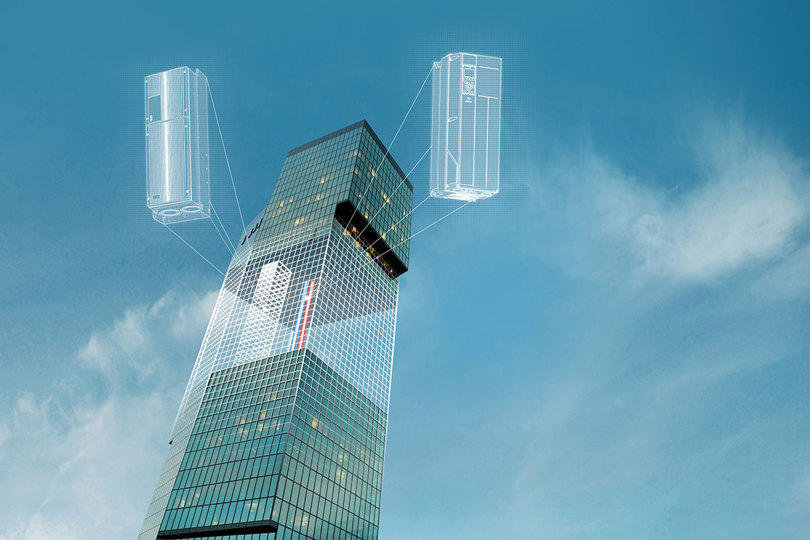
Author: JÜRGEN FISCHER, PRESIDENT OF DANFOSS COOLING SEGMENT
Published: EURACTIV
Can you imagine a world without cooling? Have you opened your fridge today to take out fresh cold milk for your morning cereals or coffee? This wouldn’t be possible without cooling technology. Cooling is not luxury. In our modern society, it’s a necessity that has strong influence on health, productivity at work, reduction of food loss, industrial processes, and more.
As technology advances and global population grow, the need for cooling is expected to increase exponentially. The European Commission expects the demand for space cooling in the EU to rise by 70% by 2030. By 2060, the cooling sector is expected to outpace the heating sector and overtake it by 60% at the end of the century. Cooling demand will also increase as our society becomes more digitized. Almost half of a data center’s electricity is used for cooling, and data center power consumption nearly quadrupled to 43GW between 2007 and 2013 – an amount equal to the generating capacity of South Africa.
It’s crucial that we lead the way towards a sustainable cooling sector. We are one week ahead of the adoption of the general approach of the Council on the Energy Efficiency Directive and the Energy Performance of Buildings Directive. This is an important milestone on the journey to achieve the full decarbonization of the cooling sector.
For me, the upcoming regulatory framework must shape our sector in five ways:
- Raise awareness about the energy-saving potential of cooling with the consumer in focus
We underestimate the importance of cooling for the moderate European climate. The refrigerator and freezer appliances found in nearly every modern home are responsible for the single biggest cooling energy load. In the UK, they consume 4% of all electricity — up to 13 TWh per year.
Refrigeration doesn’t stop in the home. Supermarkets currently use up to 2% of a country’s electricity. 70% of our foods are chilled or frozen when produced and another 50% are displayed in a refrigerator at the point of retail. Online food retail and the delivery of food to the consumer’s doorstep are projected to grow from 10% to 40% by 2027, increasing the use of refrigerated vans. - Reduce the building-level cooling demand while ensuring indoor comfort
Large buildings, particularly office buildings and hospitals, would be uninhabitable without air conditioning. The Energy Performance of Buildings Directive and the Energy Efficiency Directive must therefore be two sources to consider for the decarbonization of the building stock by 2050 (new Article 2a). Major renovation requirements and nearly-zero energy buildings will call for better ventilation and, to a certain extent, more air conditioning as buildings become better insulated. More efficient appliances, solar shading, and window technology can alleviate this demand to a certain extent, but we must also seek to integrate cooling technology with renewable energy sources. - Enable the cooling sector to accelerate the uptake of renewable energy
Driven by the 2030 climate and energy framework, 45% of electricity will be generated by renewable sources, creating the need for better energy storage and increased demand-side management. With a favorable policy environment, cooling technology can support this goal. The growing role of heat pumps is yet another way to integrate excess renewable energy capacity that needs to be further incentivized by policy.
District cooling can be the enabler to integrate excess cooling capacity and provide free cooling via lakes and natural water bodies. If we combine systems, we will find the most energy-efficient solutions. - Advance sector coupling and system thinking
Integrating heating and cooling sectors can deliver huge efficiency gains. For example, the recovery of unavoidable waste heat in supermarkets, enabled by smart buildings, can be another target area for policy. In a case study in Denmark, the heating bill of a local supermarket was reduced by 80% using heat recovery and sending the heat generated by the cooling system of the store back into the district heating network.
System thinking must be front and center. It’s possible to integrate supermarkets into the larger energy system and unlock excess capacities that amount to 70% of a compressor’s cooling capacity — which can then be made available during energy peak demand.
The technology exists – however, policy needs to encourage innovation and incentivize the required investments. Currently, several member states discourage this innovation via double taxation of heat. - Implement digitalization as an enabler for more sustainable cooling
Digitalization can be the game changer for the sector. We can already see that big data and analytics allow us to apply technology in a more intelligent way, leverage efficiency gains, and access cooling capacities that were underutilized before. Currently, 9% of produced food in the EU is lost due to lack of adequate refrigeration. Monitoring software that tracks the temperature and humidity along the cold chain can significantly reduce food loss and reduce the sector’s energy and water use. Policies to encourage energy-efficient and sufficiently monitored supply chains must therefore be another focus point in the EU.
The first steps to raise awareness and explain the importance of cooling for European citizens were taken this week at the CoolingEU launch event as part of the EU Sustainable Energy Week. This initiative kicks off a movement of industries working together across district energy, heating, cooling, ventilation and air conditioning to wake the sleeping giant of sustainable cooling.
Let’s make one thing very clear - cooling is not luxury – it is an essential part of our modern society. And if we manage to do it sustainably, we will also keep the planet cool.

Engineering the world of Tomorrow
Danfoss engineers advanced technologies that enable us to build a better, smarter and more efficient tomorrow. In the world’s growing cities, we ensure the supply of fresh food and optimal comfort in our homes and offices, while meeting the need for energy efficient infrastructure, connected systems and integrated renewable energy.
Our solutions are used in areas such as refrigeration, air conditioning, heating, motor control and mobile machinery.
Our innovative engineering dates back to 1933 and today Danfoss holds market-leading positions, employing more than 26,000 and serving customers in more than 100 countries. We are privately held by the founding family.
